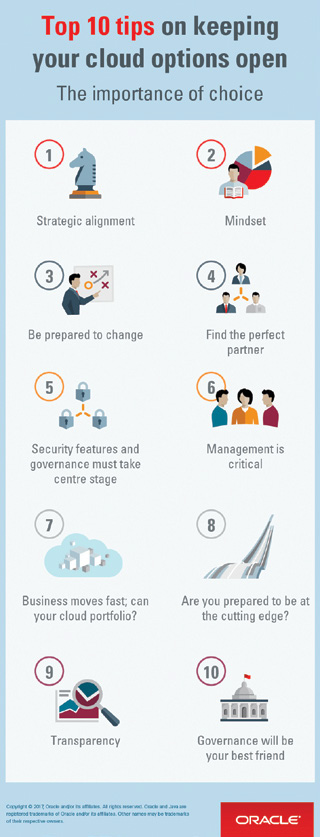THANK YOU FOR SUBSCRIBING

Top 10 Tips on Keeping Your Cloud Options Open: The Importance of Choice
Chin Ying Loong, VP Oracle Cloud Platform, ASEAN and SAGE, Oracle Corporation


Chin Ying Loong, VP Oracle Cloud Platform, ASEAN and SAGE, Oracle Corporation
Businesses in Asia Pacific are rapidly embracing cloud infrastructure (IaaS). A new research from Oracle has revealed that nearly half of businesses in APAC are agreeing that IaaS will have a role to play in their business within three years. However, from the customers I speak to across ASEAN, many are still yet to fully define what their cloud strategy is and how it should be executed. As such, I am often asked what the best approach is and which path that they should follow.
This is a challenging question as every company’s cloud journey is unique and starts from a different place, for different workloads, with different legacy infrastructure and corporate strategy. Adoption or extension into platforms or infrastructure would be nascent or baby steps for many. Some have built their entire business model on developing their own apps on PaaS and IaaS. Perceived privacy and security concerns make public cloud seemingly risky proposition for others.
Cloud strategy for businesses will vary based on where the decision maker sits in the organisation. At the business end – Sales, Service, Marketing, HR and Finance – the focus is on speed, the customer and user experience. In the IT team, there are additional criteria around integration, system performance, reliability, and security that need factoring in. Plus, there may be the need to deliver raw power in a lego brick model around compute, network and storage, all at a hyperscale for things like risk modeling, research and development, or big data crunching.
So what are the 10 questions and things you should ask yourself to ensure you give yourself choice as you migrate to cloud?
1. Strategic alignment - Ensure your cloud goals tie to your business strategy and vision. Sounds obvious, but especially IT folks, can get blinded by the latest and greatest. Do you want to be an innovator, or is your focus on de-risking, cost savings and CAPEX to OPEX cost models?
2. Mindset - You are not going to get to the future, by holding on to the past. You will need a change in mindset; are you prepared to do things differently?
3. Be prepared to change - Some companies may not be able to shift their enterprise workloads to public cloud services due to data security, compliance or latency concerns. These workloads can continue to be run on-premise through in-a-box type cloud solutions that, in some cases, can offer the same cost structure and flexibility as the public cloud. Other organisations may choose to embrace a hybrid cloud model for development and testing to validate the business case of using public and private clouds.The key benefits of cloud is its capacity for adding in new features and capabilities quickly

4. Find the perfect partner - Business is complex. You need cloud solutions optimised to run an enterprise workload to get all the value of cloud from an economic perspective, and have all your security and data concerns taken into account. Can you find a vendor, managed cloud provider or broker that can help you understand the full range of opportunities that cloud provides as well as what the future of enterprise cloud looks like?
5. Security features and governance must take centre stage - The conversation around Cloud should start here rather than for these areas to be bolted on solutions after the main architecture is decided.
6. Management is critical - Will you have visibility into and across all of the cloud elements you are adding into your infrastructure, so you can ensure they are delivering value, and are meeting corporate requirements on security, privacy and so on? At a base level, you also do not want cloud test and development environments being running when not in use – that does not bring the economic advantage you turned to cloud for in the first place.
7. Business moves fast; can your cloud portfolio? - You need to be able to switch back and forth between on premises and cloud, and mix and match a variety of options as your approach to cloud matures.
8. Are you prepared to be at the cutting edge? - One of the key benefits of cloud is its capacity for adding in new features and capabilities quickly, in a matter of weeks or months rather than yearlong release cycles. But don’t panic, operating in constant change is the new stable.
9. Transparency - If you are actually locking yourself into a provider, you will not realise the need for risk mitigation, and will likely lose some or all of the financial and performance gains you anticipated. Ask what a migration from this cloud to that one would look like in six months time.
10. Governance will be your best friend - When you need to audit, down the NIC level, when you need to attest to exactly what and where your data is, will your provider be part of your solution or the problem itself?
You need to adopt cloud in a way that meets where you are today as well as allowing room for growth. Most likely that will mean a hybrid cloud structure for a time, and it will include the need to use multiple tiers of cloud services.
Weekly Brief
I agree We use cookies on this website to enhance your user experience. By clicking any link on this page you are giving your consent for us to set cookies. More info
Read Also













